Due to the nature of the draw for the 2018 World Cup in Russia we saw England and Tunisia have to wait until the second last day of the first round of fixtures to play their first game in the tournament. This can of course be both a positive and a negative with the sides playing later having a chance to see and assess their competitors in action before they have to reveal their hand in terms of tactical structure. On the other hand though the long wait can lead to growing nerves around the squad, interestingly this year this does not appear to be the case with the England squad who seem to have prepared very well.
As the game started we saw England impress hugely over the course of the first thirty minutes. They played with genuine attacking intent and with pace that will frighten many sides in the tournament with the likes of Jesse Lingard and Dele Alli dropping in and out of pockets of space in and around the final third of the field.
However, as the game progressed with the Tunisians being awarded a somewhat controversial penalty in the first half we saw England lose momentum for a 20-30 minute period. During this period Tunisia enjoyed periods of possession although they failed to achieve genuine penetration of the English defensive block. Fortunately for England their coach Gareth Southgate made two intelligent changes with the introduction of Ruben Loftus-Cheek and Marcus Rashford putting England back on the front foot.
England defenders breaking the lines
Much was made prior to the start of the tournament of the decision by Gareth Southgate to switch to a 3-5-2 structure away from the previous 4-2-3-1 has elicited much debate in the media in the run up to the tournament getting underway. There is still a question mark over whether playing with three central defenders will inhibit the attacking phase for England when they play against more compact and defensive opponents but those questions were well and truly answered with the performances of Harry Maguire, John Stones and Kyle Walker as central defenders.
The change to three at the back coupled with the emergence of Maguire and Stones in particular has given England a more solid base from which to build in the attacking phase. This in turn allows the more attack minded central midfielders to flow forward to join the attacking line and force the opposition defensive block back, thus opening space for the defenders and wing backs to occupy higher positions on the field.
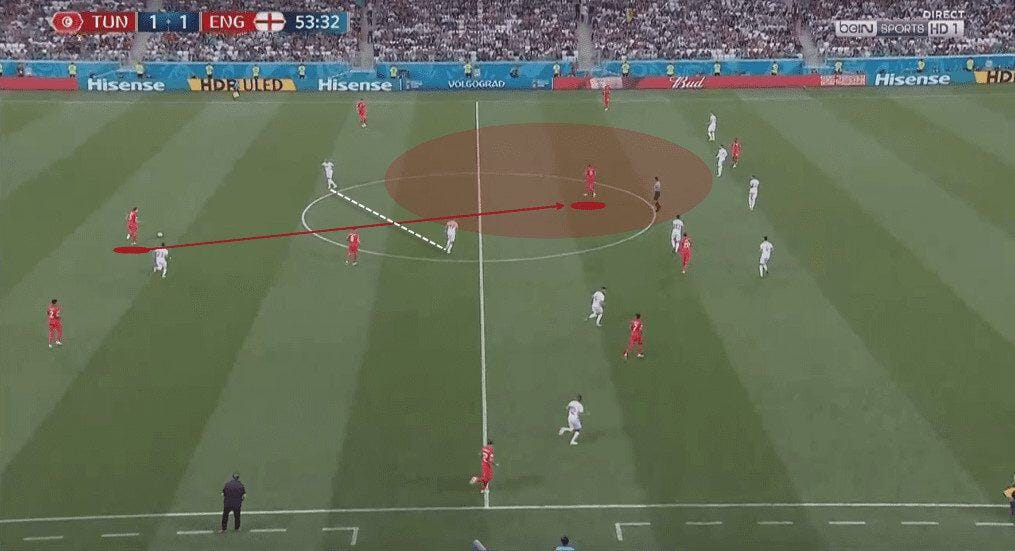
Here with John Stones in possession we can see the beginnings of this mechanism in action. The Tunisian defensive block is caught in transition and the three more advanced players are poorly spaced, this creates the opportunity for one of the advanced midfielders to drop in to a pocket of space centrally and receive the pass from Stones.
Having central defenders like Walker, Maguire and Stones gives England the base from which to attack as all three are comfortable whether passing to break the lines of opposition pressure of driving forward with the ball to provoke pressure from the opposition and break in to the defensive structure.
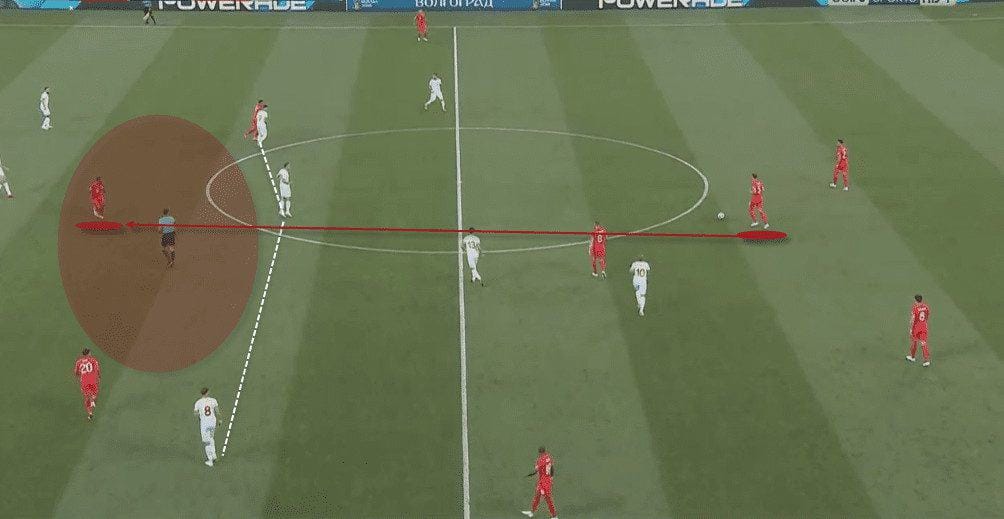
Again here we see a similar moment for England as they look to attack. Stones is again in possession and rather than looking for an opportunity to play in to the midfield in front of the midfield line he again has the quality to find Raheem Stirling in behind that first line of the defensive structure.
As soon as this pass is completed, particularly in a central area to a player like Stirling, gives England a huge platform from which they can attack and threaten to penetrate the opposition penalty area.
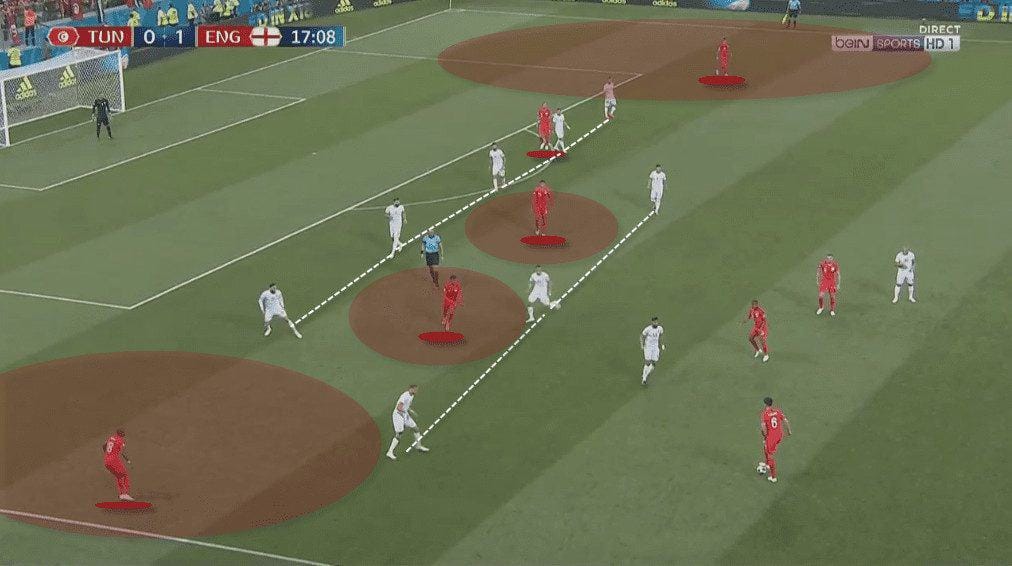
You can see here the kind of attacking structure that England were able to create in the first half of the match. With Ashley Young and Kieran Tripper attacking the wide areas and stretching the width of the field, England always have an option to play in to the wide area. You can also see the spaces in between the midfield and defensive lines that Deli Alli and Jesse Lingard were able to occupy.
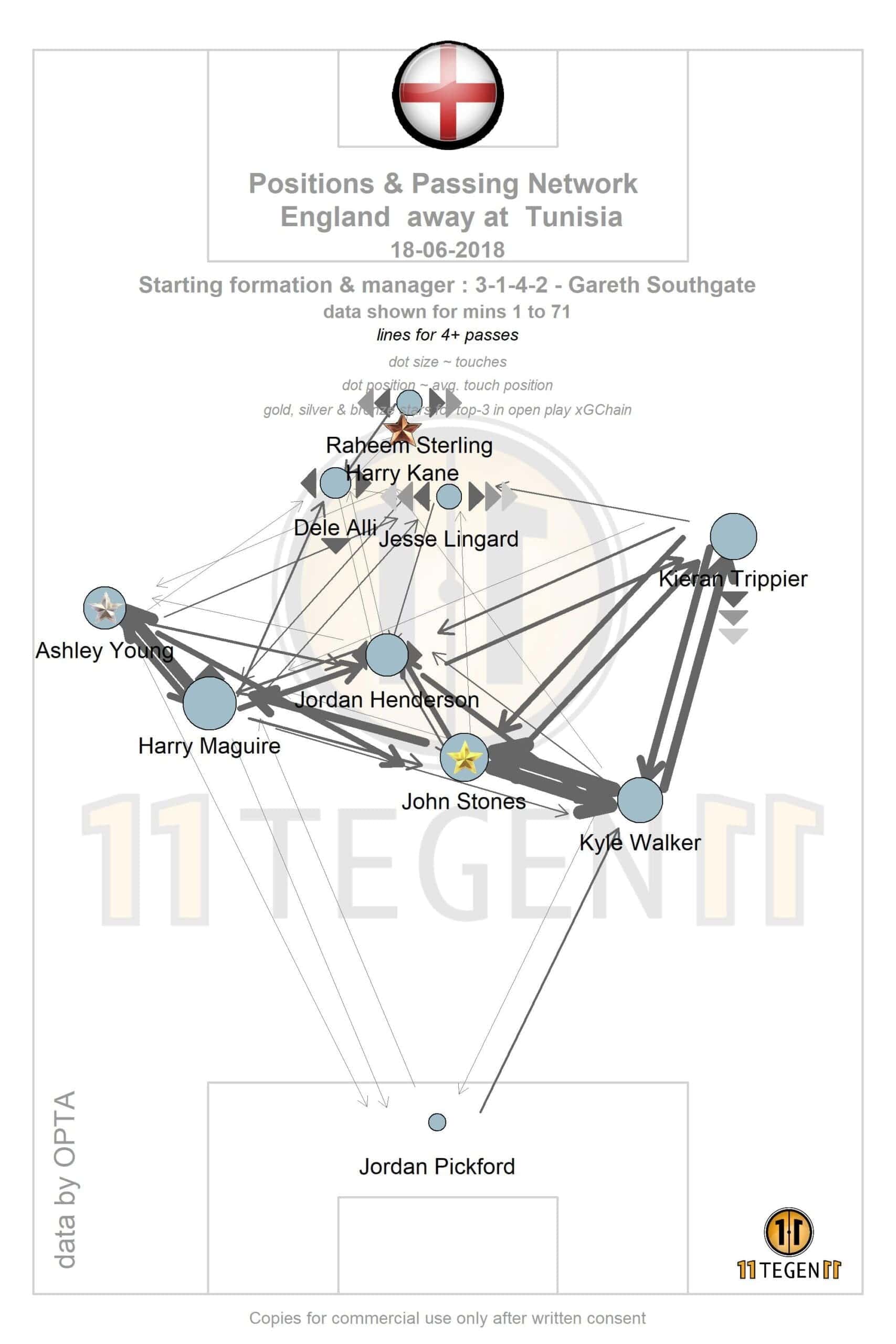
You can also see from this pass map, supplied by the excellent @11tegen11 using Opta data, that Harry Maguire and John Stones were excellent at moving up towards the same line as Jordan Henderson in midfield to create that platform and allow Lingard and Alli to move up to support the front players in possession.
Kieran Tripper dominates the wide area
When the final 23 man squad was announced by England coming in to this tournament it was interesting to note that there were three players included who all essentially played right back for their club sides in Kyle Walker, Kieran Tripper and Trent Alexander Arnold. Now it appears clear that this choice was informed by the fact that Walker would play as the right sided centre back.
For the first match of the tournament Kieran Tripper was selected as the right sided wing back and his performances more than vindicated his selection. Throughout the match, including the period at the start of the second half where England lost their momentum, Tripper was excellent both in terms of getting forward to occupy high areas and stretch the defensive block of Tunisia and when knowing to show in deeper areas to support the build up play.
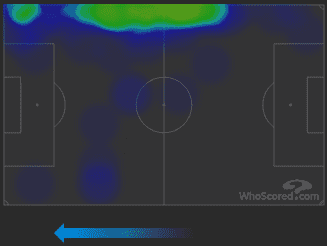
As you can see from his heatmap, supplied by WhoScored, Trippier provided a very specific function for the England team with his positioning, tight to the touchline, creating space in the half space and central areas for teammates to flow in to and occupy.
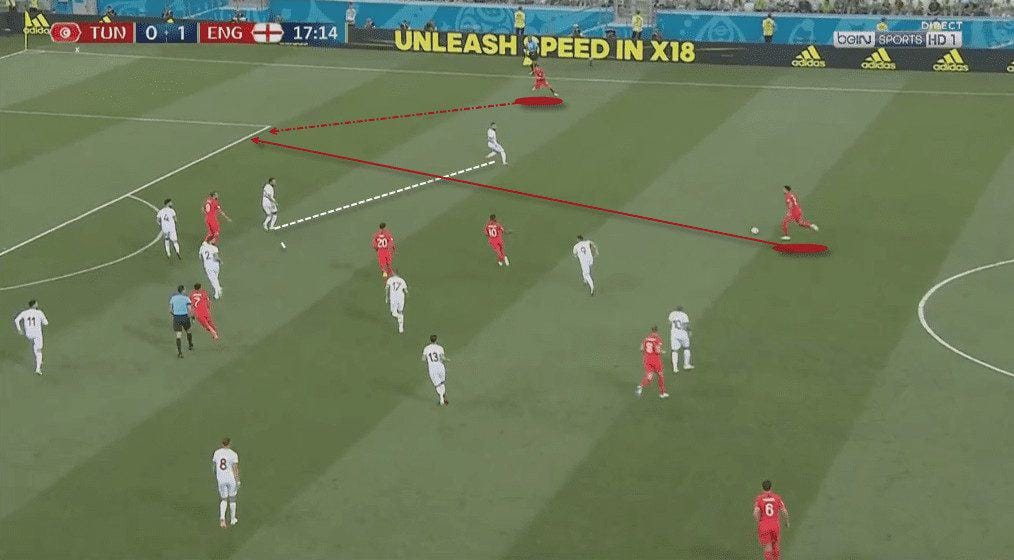
Here we see Trippier getting in behind the Tunisian defensive line to penetrate the penalty area and create a goal scoring opportunity for his teammate. The pass is played, by Kyle Walker from central defence, in between the gap created between the left back and central defender for Tunisia. This gap was created by Trippier constantly staying wide on the touchline.
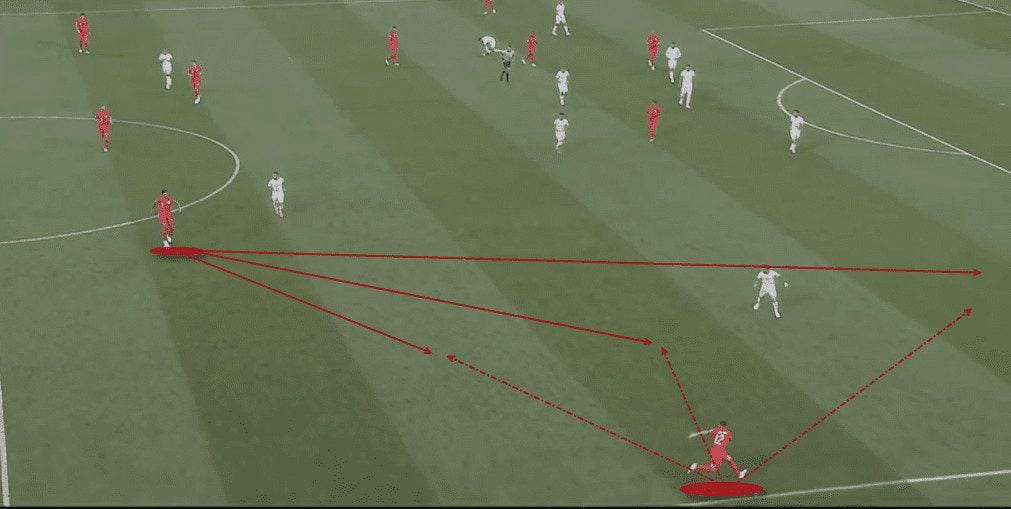
This time we see Trippier again isolated against the opposition full back. During the match we saw Trippier make movements to collect passes like all three that are shown. He had gone long to get in behind the fullback, he had dropped short to retain possession and support the build up and he has checked just inside to collect the ball and combine with central players.
This in turn keeps the left back off balance not sure how to best position himself and this gives Trippier a distinct advantage over his direct opponent.
Harry Maguire – Playmaker
In the aftermath of the match I have heard pundits on the main networks being slightly critical of the Leicester defender Maguire in the way that he lost possession at times, Indeed one particular commentator lamented that Maguire needs to learn when to ‘get rid of the ball’ instead of always trying to play.
Whilst it is easy to see where this type of punditry is coming from it is somewhat missing the point in that Maguire is playing a specific role for the team and that it is his ability on the ball that has secure his place in the starting line up for the tournament.
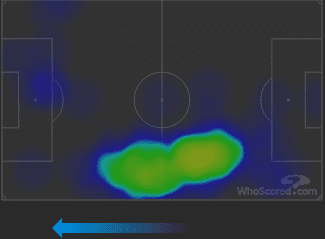
The heatmap for Maguire, once again courtesy of WhoScored, is indicative of his performance throughout the match as it shows just how advanced he played as England forced the Tunisians back and Maguire became an important playmaker in the midfield line alongside Jordan Henderson.
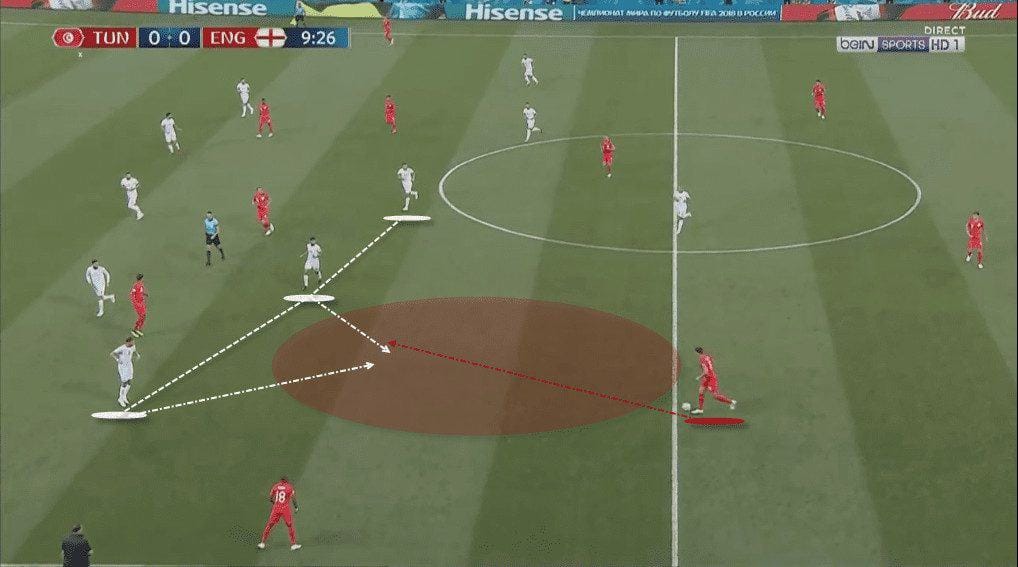
The scene was very much set in the first ten minutes of the match as Tunisia looked to remain compact and prevent England from creating space to play between the lines. This is where a player like Maguire can be an essential tool in the build up. Not only is he able to pass the ball through the lines where needed he is also comfortable enough on the ball to carry the ball forward in to the opposition half.
As soon as he does this and runs forward in possession the two nearest opponents start to come out of the defensive block to engage the ball. This immediately creates space in behind and outside them which England can access to play through the defensive structure.
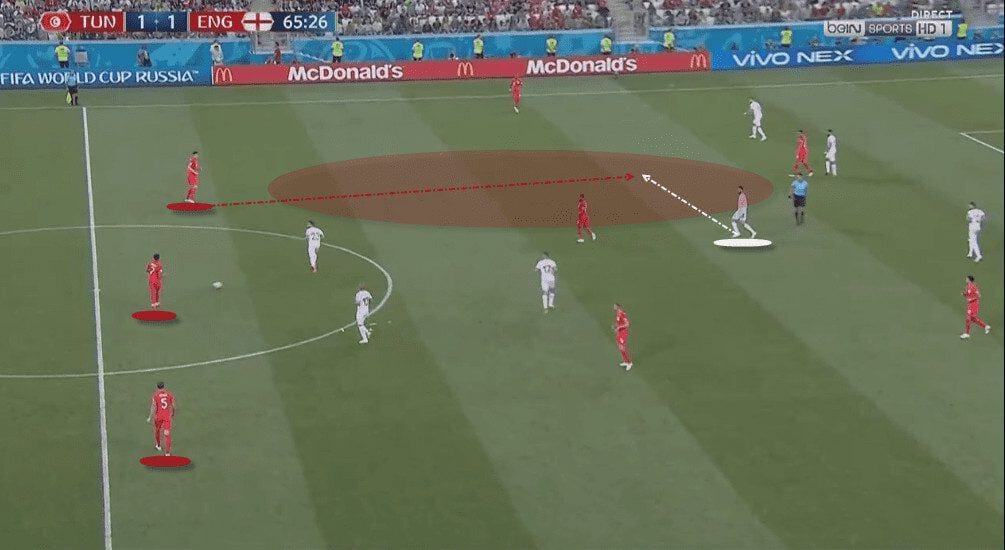
In the second half as England lost their way and lost momentum it was the positive play of the likes of Trippier and Maguire, alongside the excellent Ruben Loftus Cheek when he was introduced that brought them back in to the ascendancy.
Here the ball is switched over to Maguire where he has space to move in to. The defender does not hesitate and drives forward in possession forcing an opposition player at the centre of their defensive structure to step out and engage the ball. As soon as he does so the space is created centrally and England are able to build a central platform from which they can attack.
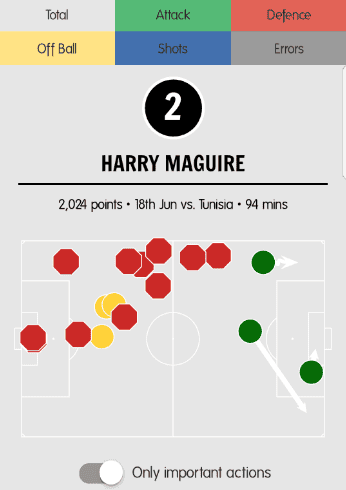
The above graphic is taking from the excellent Twelve Football site, created by David Sumpter. They assign points to each player in each match they cover for each action that increases their teams chances of scoring a goal or decreases the oppositions chances of scoring a goal. In this match Harry Maguire scores second in their model with 2,024 points, second only behind Harry Kane courtesy of his two goals. As you can see Maguire was proactive in his defensive phase with recoveries in the opposition half as well as key attacking contributions in terms of passes.
Conclusion
It may have taken an extremely late goal from Harry Kane but there is no doubt that England were the deserving winners with their impressive and proactive attacking play over the first 30 minutes of the match.
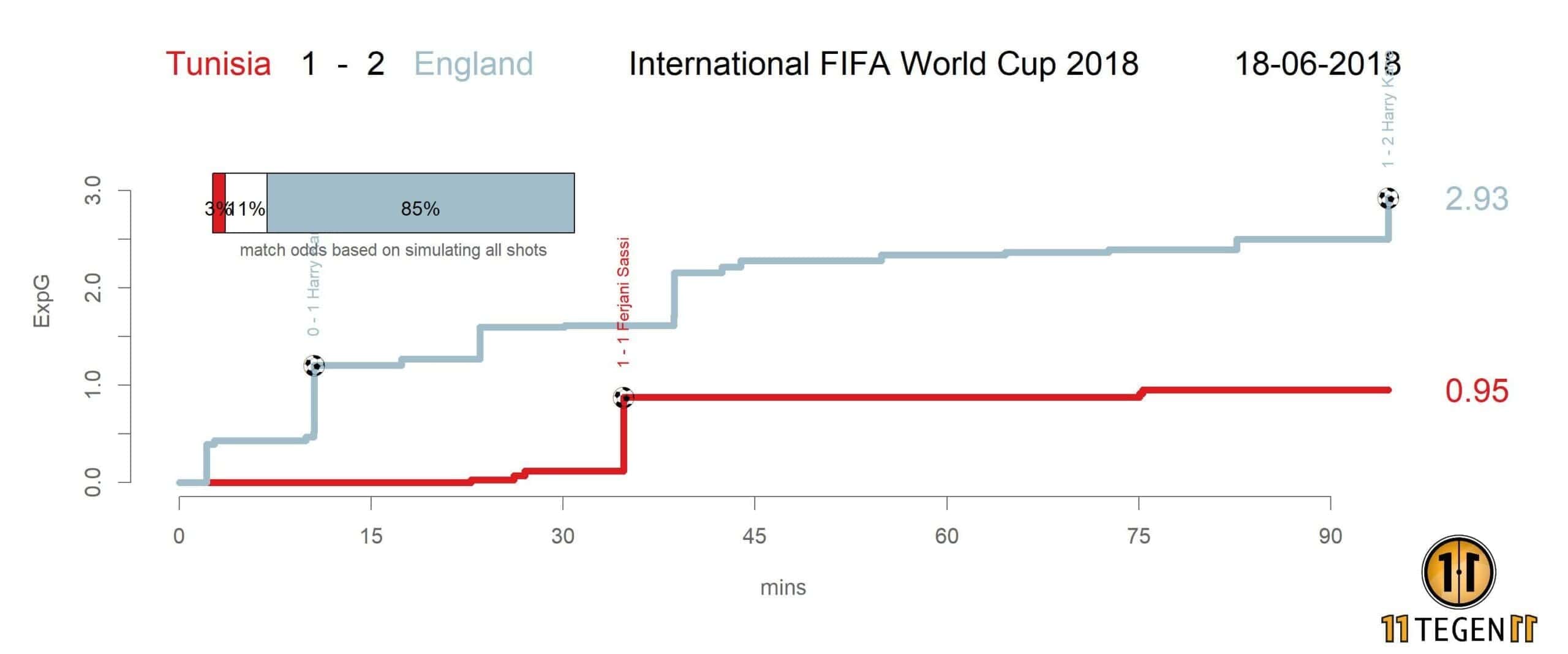
The expected goals data, supplied once again by @11tegen11 using Opta data, had England winning by 2.93 to 0.95 indicative of the quality of chances created by England throughout the match. If the English can keep up this form for the rest of the group stage we should see them qualify comfortably from the group stage.





Comments